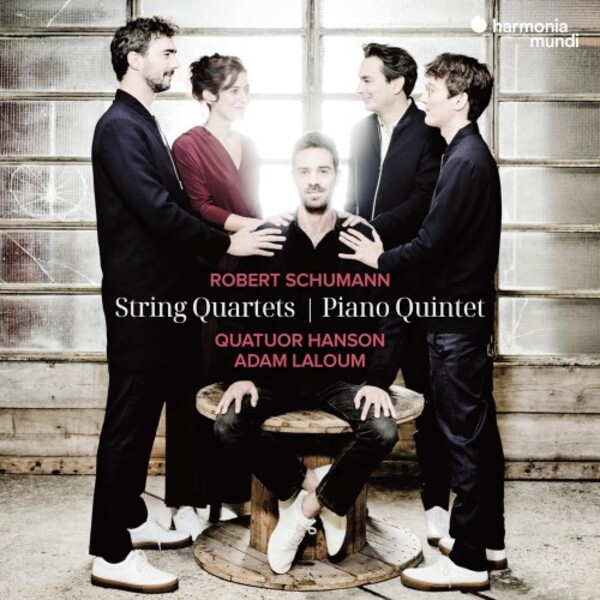SCHUMANN String Quartets. Piano Quintet
View record and artist detailsRecord and Artist Details
Genre:
Chamber
Label: Harmonia Mundi
Magazine Review Date: 09/2024
Media Format: CD or Download
Media Runtime: 114
Mastering:
DDD
Catalogue Number: HMM90 2726-27

Tracks:
| Composition | Artist Credit |
|---|---|
| String Quartet No. 1 |
Robert Schumann, Composer
Hanson Quartet |
| String Quartet No. 2 |
Robert Schumann, Composer
Hanson Quartet |
| String Quartet No. 3 |
Robert Schumann, Composer
Hanson Quartet |
| Quintet for Piano and Strings |
Robert Schumann, Composer
Adam Laloum, Piano Hanson Quartet |
Author: Rob Cowan
As musical birthday presents go, Schumann’s three string quartets vie with Wagner’s Siegfried Idyll – both were dedicated to the composers’ respective wives – as among the most touching ever written. Schumann’s three-tier Op 41 was composed in a short space of time in 1842, two years after Schumann’s outpouring of some 140 songs. Indeed, there are frequent reminders of the lieder genre throughout the cycle, most tellingly at the Andante espressivo start of Op 41 No 3, the opening two-note phrase strongly suggestive of the word ‘Liebe’. Quatuor Hanson embrace this music as if in a romantic fairy tale, cellist Simon Dechambre lovingly grounding the group’s sound, similar in style to the equally distinctive – and recently reissued – Cherubini Quartet (where the cellist is Manuel Fischer-Dieskau – see page 93), except that Quatuor Hanson ply a richer pooled tone. The Cherubini are more agile and transparent, but either recording will convey the essence of this bewitching music.
Turn to Op 41 No 1, the opening (another Andante espressivo), and the Cherubini opt for a more flowing tempo than Quatuor Hanson, which to these ears suits the music’s falling cadences more comfortably. By contrast, the Cherubini’s Scherzo is the more demonic of the two, the Hanson more expressive in the Adagio (a subtle use of portamento helps see to that), the Cherubini marginally more animated at the start of the Second Quartet, a good deal swifter in the Andante quasi variazioni, too.
To be truthful, both sets are involving, the Hanson the more overtly romantic, and I might additionally cite the vibrantly expressive versions with the Doric, Emerson, Fine Arts and Guarneri Quartets (Chandos, Pentatone, Naxos and RCA respectively). The Emerson in particular (who, like the Fine Arts and the Doric, accommodate all three quartets on a single CD) bring a high degree of drama to No 3, the first movement especially, as do the Doric, who also court some extreme dynamics.
The Hanson and Cherubini Quartets add the much-loved Piano Quintet in markedly different performances, the former with a very sensitive Adam Laloum, the latter with Christian Zacharias drawing rhetorical emphases, often where none need be drawn. Whether you find his playing invigorating or distracting will be down to personal taste. There are no such issues with Laloum and Quatuor Hanson, a wholly excellent performance, pleasing and competitive.
Discover the world's largest classical music catalogue with Presto Music.

Gramophone Digital Club
- Digital Edition
- Digital Archive
- Reviews Database
- Full website access
From £8.75 / month
Subscribe
Gramophone Full Club
- Print Edition
- Digital Edition
- Digital Archive
- Reviews Database
- Full website access
From £11.00 / month
Subscribe
If you are a library, university or other organisation that would be interested in an institutional subscription to Gramophone please click here for further information.




